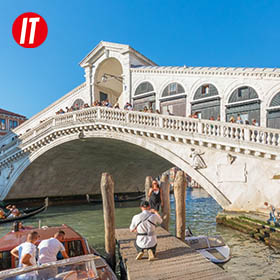Ponte Sant'Angelo
Angels With Instruments of the Passion
The Ponte Sant'Angelo, built by Hadrian in 139 AD, spans the banks of the River Tiber and leads to the Castel Sant'Angelo and St. Peter's Basilica. With many renovations, it is guarded with 10 statues of angels created by Bernini and his apprentices.
The Ponte Sant’Angelo is definitely the most popular and well-known bridge in Rome, spanning both sides of the Tiber River and famous for the vibrant statues of angels on the bridge.
Completed in 139 AD, this Bridge of the Holy Angel was originally built by Roman Emperor Hadrian as a bridge for his own mausoleum, Castel Sant'Angelo. The original three arches underneath the bridge were transformed into a five-arch stone bridge by later generations, and the three arches in the middle are Roman period originals. The Stone Bridge and the Castle are as if a pair of inseparable partners, they stand beside the Tiber River quietly watching the rise and fall of Rome.
To this day, the Ponte Sant’Angelo is the main access point to the Castel Sant’Angelo and the Vatican. The bridge is Leading to the Gate of Castel Sant'Angelo, are is restricted to pedestrians only. The angels standing on either side of the bridge will guide you into the most sacred realm of Catholicism, the jurisdiction of the Holy See.
Manywhere Trivia:
Many people mistakenly believe that the bridge is named after the angels on the bridge, but the name “Holy Angel” comes from St. Michael the Archangel (the one on the roof of Castel Sant’Angelo), who appeared at the end of the plague in 590 AD, more than 1,000 years before the statues on the bridge.
The 10 Angel Statues on the Ponte Sant’Angelo was completed around 1669 by the famous Italian sculptor Bernini, with his apprentices. These angels hold the instruments of the Passion used during the crucifixion of Jesus, such as the crown of thorns, crosses, stone pillars and nails, in vivid and vivid poses, two of which were built by Bernini himself.
Across the bridge, the Castel Sant’Angelo, which was converted from a tomb of Hadrian 2,000 years ago to a military barracks, prison and papal refuge, has become one of Rome’s most popular museums open to visitors in recent years.

Castel Sant'Angelo
The Pope's Fortress and Refuge
The Castel Sant'Angelo is a mausoleum built by the Roman Emperor Hadrian for himself, which served as a barracks, a prison, and a refuge for the Pope. The castle has a papal residence, Hadrian's crypt and several rooms with frescoes. Its rooftop observation deck overlooks the city of Rome.
Attractions around the Ponte Sant’Angelo
- Castel Sant'Angelo
- St. Peter's Basilica And St. Peter's Square
- Vatican Museums
- Piazza Navona
- Sant'Andrea della Valle
- Pantheon
Tags:
Related
Daigoji Temple360
Hideyoshi Toyotomi's Cherry Blossom PartyOsaka Station / Umeda Commercial District360
The Nexus of KantoStadthuys / History And Ethnography Museum360
The Oldest Dutch Building in AsiaOlympiapark Munich360
Venue of the 20th Summer OlympicsCasa Mila / La Pedrera360
Modernist Building Before Its TimeThe Lama Temple360
Tibetan Buddhism in BeijingThe Palace Museum - Six Palaces of East Road360
Residences for ConcubinesBerrick Hall360
Largest Western-style House in YamatePiazzale Michelangelo360
Overlooking FlorenceHeian Jingu Shrine360
1100th Anniversary of Moving the CapitalMatthias Church360
The legendary King of HungaryTenryuji Temple360
Pond Views of Four Seasons




























No comments yet, post the first one!